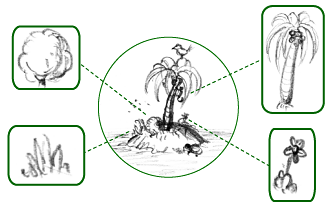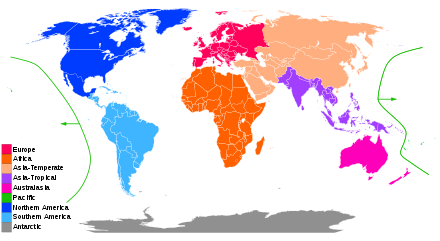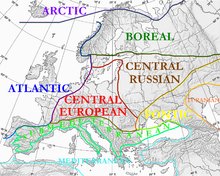Flora

Flora is the plant life occurring in a particular region or time, generally the naturally occurring or indigenous—native plant life. The corresponding term for animal life is fauna. Flora, fauna and other forms of life such as fungi are collectively referred to as biota. Sometimes bacteria and fungi are also referred to as flora, as in the terms gut flora or skin flora.[1][2][3]
Contents
1 Etymology
2 Flora classifications
3 Documentation of floras
4 See also
5 References
6 External links
Etymology
The word "flora" comes from the Latin name of Flora, the goddess of plants, flowers, and fertility in Roman mythology.[4][citation needed]
The distinction between vegetation (the general appearance of a community) and flora (the taxonomic composition of a community) was first made by Jules Thurmann (1849). Prior to this, the two terms were used indiscriminately.[5][6]
Flora classifications
Plants are grouped into floras based on region (floristic regions), period, special environment, or climate. Regions can be distinct habitats like mountain vs. flatland. Floras can mean plant life of a historic era as in fossil flora. Lastly, floras may be subdivided by special environments:
Native flora. The native and indigenous flora of an area.
Agricultural and horticultural flora (garden flora). The plants that are deliberately grown by humans.
Weed flora. Traditionally this classification was applied to plants regarded as undesirable, and studied in efforts to control or eradicate them. Today the designation is less often used as a classification of plant life, since it includes three different types of plants: weedy species, invasive species (that may or may not be weedy), and native and introduced non-weedy species that are agriculturally undesirable. Many native plants previously considered weeds have been shown to be beneficial or even necessary to various ecosystems.
Documentation of floras

The botanical continents of the World Geographical Scheme for Recording Plant Distributions, used for classifying floras geographically

Floristic regions in Europe according to Wolfgang Frey and Rainer Lösch
The flora of a particular area or time period can be documented in a publication also known as a "flora" (often capitalized as "Flora" to distinguish the two meanings when they might be confused). Floras may require specialist botanical knowledge to use with any effectiveness. Traditionally they are books, but some are now published on CD-ROM or websites.
It is said that the Flora Sinensis by the Polish Jesuit Michał Boym was the first book that used the name "Flora" in this meaning, a book covering the plant world of a region.[7] However, despite its title it covered not only plants, but also some animals of the region.
A published flora often contains diagnostic keys. Often these are dichotomous keys, which require the user to repeatedly examine a plant, and decide which one of two alternatives given best applies to the plant.
See also
Biome — a major regional group of distinctive plant and animal communities- Fauna
- Fauna and Flora Preservation Society
- Herbal
- Horticultural flora
- Megaflora
- Pharmacopoeia
- The Plant List
Vegetation — a general term for the plant life of a region
- Categories
- Flora by continent
- Flora by country
- Flora by region
References
^ "Merriam Webster Online Dictionary"..mw-parser-output cite.citation{font-style:inherit}.mw-parser-output .citation q{quotes:"""""""'""'"}.mw-parser-output .citation .cs1-lock-free a{background:url("//upload.wikimedia.org/wikipedia/commons/thumb/6/65/Lock-green.svg/9px-Lock-green.svg.png")no-repeat;background-position:right .1em center}.mw-parser-output .citation .cs1-lock-limited a,.mw-parser-output .citation .cs1-lock-registration a{background:url("//upload.wikimedia.org/wikipedia/commons/thumb/d/d6/Lock-gray-alt-2.svg/9px-Lock-gray-alt-2.svg.png")no-repeat;background-position:right .1em center}.mw-parser-output .citation .cs1-lock-subscription a{background:url("//upload.wikimedia.org/wikipedia/commons/thumb/a/aa/Lock-red-alt-2.svg/9px-Lock-red-alt-2.svg.png")no-repeat;background-position:right .1em center}.mw-parser-output .cs1-subscription,.mw-parser-output .cs1-registration{color:#555}.mw-parser-output .cs1-subscription span,.mw-parser-output .cs1-registration span{border-bottom:1px dotted;cursor:help}.mw-parser-output .cs1-ws-icon a{background:url("//upload.wikimedia.org/wikipedia/commons/thumb/4/4c/Wikisource-logo.svg/12px-Wikisource-logo.svg.png")no-repeat;background-position:right .1em center}.mw-parser-output code.cs1-code{color:inherit;background:inherit;border:inherit;padding:inherit}.mw-parser-output .cs1-hidden-error{display:none;font-size:100%}.mw-parser-output .cs1-visible-error{font-size:100%}.mw-parser-output .cs1-maint{display:none;color:#33aa33;margin-left:0.3em}.mw-parser-output .cs1-subscription,.mw-parser-output .cs1-registration,.mw-parser-output .cs1-format{font-size:95%}.mw-parser-output .cs1-kern-left,.mw-parser-output .cs1-kern-wl-left{padding-left:0.2em}.mw-parser-output .cs1-kern-right,.mw-parser-output .cs1-kern-wl-right{padding-right:0.2em}
^ Clifford E. Starliper; Rita Villella; Patricia Morrison; Jay Mathais. "Sampling the bacterial flora of freshwater mussels" (PDF).
^ John, D.M.; Whitton, B.A.; Brook, A.J. (2002). The Freshwater Algal Flora of the British Isles: An Identification Guid to Freshwater and Terrestrial Algae. Cambridge University Press. ISBN 9780521770514.
^ Rengel, Kathleen N. Daly ; revised by Marian; Daly, Kathleen (2009). Greek and Roman mythology, A to Z (3rd ed.). New York: Chelsea House Publishers. ISBN 1604134127.
^ Thurmann, J. (1849). Essai de Phytostatique appliqué à la chaîne du Jura et aux contrées voisines. Berne: Jent et Gassmann, [1].
^ Martins, F. R. & Batalha, M. A. (2011). Formas de vida, espectro biológico de Raunkiaer e fisionomia da vegetação. In: Felfili, J. M., Eisenlohr, P. V.; Fiuza de Melo, M. M. R.; Andrade, L. A.; Meira Neto, J. A. A. (Org.). Fitossociologia no Brasil: métodos e estudos de caso. Vol. 1. Viçosa: Editora UFV. p. 44-85. [2]. Earlier version, 2003, [3].
^ Flora Sinensis Archived 2010-02-06 at the Wayback Machine (access to the facsimile of the book, its French translation, and an article about it)
External links
| Wikimedia Commons has media related to Flora. |
eFloras — a collection of on-line floras
Chilebosque — checklist of Chilean native flora
Flora of NW Europe with descriptions and a quiz to test your knowledge- Flora of Australia Online
- Flora of New Zealand Series Online
